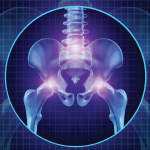Scleroderma is another rheumatologic disease in which involvement of fasciae may be more important than generally recognized. Most of the research has focused on the skin, which is easily accessed via punch biopsies, even though it is well recognized clinically that deeper connective tissues are frequently involved, as well (tendon friction rubs, for example, are clinically associated with poor outcomes).13 Ultrasound imaging so far has been mostly used to examine the skin, but could be a useful tool to examine deeper connective tissues and determine whether their involvement is related to disease progression.14
Fascia and the Immune System
Another aspect of fascia that has escaped attention is its role in normal immune surveillance and regulation. It is well recognized that an important component of the immune response occurs within the connective tissue matrix. What is less well recognized is that this same matrix is also part of the musculoskeletal system, and is constantly subjected to mechanical forces during body movements and changes in body posture. In vitro, mechanical forces have profound influences on cellular function, but their impact on body systems in vivo is less well understood. It was recently shown that “loose” areolar connective tissue locally adjusts its level of tension in response to stretching and shortening of the tissue.15 This tension regulation results from the dynamic, cytoskeletal remodeling of fibroblasts that occurs within minutes in response to a sustained change in tissue length. We also know that fibroblasts use integrin-dependent cytoskeletal mechanisms to actively restrain the matrix and prevent it from swelling in the absence of inflammation, while allowing rapid swelling by “letting go” of focal adhesions in the presence of inflammatory mediators such as interleukin 6 and tumor necrosis factor–alpha.16 Dynamic fibroblast responses to both tissue tension and inflammation may be important interrelated factors in the regulation of interstitial fluid flow, lymphatic drainage and the movement of immune cells from connective tissues to lymphoid organs.17 If this is true, body movements (e.g., change in position, exercise, stretching) could play an important role in immune surveillance mechanisms and possibly in autoimmunity.
In summary, fasciae are an integral part of the musculoskeletal system that has been poorly studied. The time has come to address this issue and fill in the blanks.
Dr. Langevin is professor in residence of medicine in the division of preventive medicine at Brigham and Women’s Hospital, Harvard Medical School, in Boston.
References
- Benjamin M. The fascia of the limbs and back—a review. J Anat. 2009;214:1-18.
- Schmidt-Wilcke T, Clauw DJ. Fibromyalgia: From pathophysiology to therapy. Nat Rev Rheumatol. 2011:7:518-527.
- Myburgh C, ALarsen AH, Hartvigsen J. A systematic, critical review of manual palpation for identifying myofascial trigger points: Evidence and clinical significance. Arch Phys Med Rehabil. 2008;89:1169-1176.
- Barbero M, Cescon C, Tettamanti A, et al., Myofascial trigger points and innervation zone locations in upper trapezius muscles. BMC Musculoskelet Disord. 2013;14:179.
- Taguchi T, Hoheisel U, Mense S. Dorsal horn neurons having input from low back structures in rats. Pain. 2008;138:119-129.
- Corey SM, Vizzard MA, Badger GJ, Langevin HM. Sensory innervation of the nonspecialized connective tissues in the low back of the rat. Cells Tissues Organs. 2011;194:521-530.
- Tesarz J, Hoheisel U, Wiedenhöfer B, Mense S. Sensory innervation of the thoracolumbar fascia in rats and humans. Neuroscience. 2011;194:302-308.
- Hoheisel U, Taguchi T, Treede RD, Mense S. Nociceptive input from the rat thoracolumbar fascia to lumbar dorsal horn neurones. Eur J Pain. 2011;15: 810-815.
- Langevin HM, Stevens-Tuttle D, Fox JR, et al. Ultrasound evidence of altered lumbar connective tissue structure in human subjects with chronic low back pain. BMC Musculoskelet Disord. 2009;10:151.
- Langevin HM, Fox JR, Koptiuch C, et al. Reduced thoracolumbar fascia shear strain in human chronic low back pain. BMC Musculoskelet Disord. 2011;12:203.
- Corey SM, Vizzard MA, Bouffard NA, Badger GJ, Langevin HM. Stretching of the back improves gait, mechanical sensitivity and connective tissue inflammation in a rodent model. PLoS One. 2012;7:e29831.
- Bouffard NA, Cutroneo KR, Badger GJ, et al. Tissue stretch decreases soluble TGF-beta1 and type-1 procollagen in mouse subcutaneous connective tissue: Evidence from ex vivo and in vivo models. J Cell Physiol. 2008;214:389-395.
- Stoenoiu MS, Houssiau FA, Lecouvet FE. Tendon friction rubs in systemic sclerosis: A possible explanation—an ultrasound and magnetic resonance imaging study. Rheumatology. 2013;52:529-533.
- Akesson A, Hesselstrand R, Scheja A, Wildt M. Longitudinal development of skin involvement and reliability of high frequency ultrasound in systemic sclerosis. Ann Rheum Dis. 2004;63:791-796.
- Langevin HM, Bouffard NA, Fox JR, et al. Fibroblast cytoskeletal remodeling contributes to connective tissue tension. J Cell Physiol. 2011;226:1166-1175.
- Reed RK, Lidén Å, Rubin K. Edema and fluid dynamics in connective tissue remodelling. J Mol Cell Cardiol. 2010;48:518-523.
- Langevin HM, Nedergaard M, Howe AK. Cellular control of connective tissue matrix tension. J Cell Biochem. 2013;114:1714-1719.

